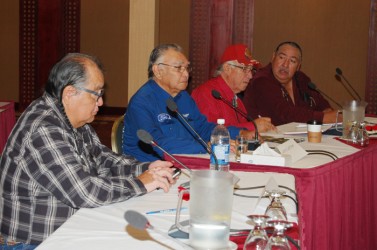Article Origin
Volume
Issue
Year
First Nations and Métis are not taking lightly the opportunity they have been given to talk to both the National Energy Board and Kinder Morgan representatives. And they want to ensure that neither the NEB nor the pipeline company take their responsibility to listen lightly either.
“So we see negative impacts of development like this and we have relayed important information to you to consider in making this decision. It is only when our concerns are meaningfully addressed before — beforehand that we will be willing to consider if this is viable,” said Norine Saddleback, consultation coordinator for the Samson Cree Nation. “Any decision to move forward with this project without our concerns being fully studied or accommodated is going to be problematic for you and the Harper government that supports this project.”
The Samson Cree Nation was joined by the O’Chiese, Sunchild, and Michel First Nations along with the Gunn Métis Settlement in providing oral traditional evidence to the NEB, which is considering Kinder Morgan’s expansion proposal for the Trans Mountain pipeline. The presentations, made between Aug. 27-Sept. 4, were the first oral traditional evidence gathered by the NEB.
The $5.4-billion Trans Mountain Expansion project would roughly triple the capacity of an existing oil pipeline between Strathcona County and a Burnaby, B.C., marine terminal to 890,000 barrels per day. Approximately 994 km of new pipeline will be built and 193 km of pipeline reactivated. Twenty new tanks will be added to existing storage terminals, including five in Edmonton. The proposed new pipeline, which includes a stretch between Edmonton and Hinton along Highway 16, will carry heavier oils. The Trans Mountain pipeline first began operating in 1953 and since then has seen a number of expansions.
The NEB heard that the proposed pipeline construction would occur close to Aboriginal homes as well as cross waterways, ceremonial grounds, and possible burial sites. Presenters also made it clear that boundaries which marked their lands and reserves were artificial. They talked about how they once gathered medicines, hunted, fished, and camped in areas that are no longer available to them because the lands have been impacted by industry or now sit as private property. They talked about how their people were buried where they died and there was concern that construction could unearth graves. They talked about their spiritual connection to the land. They talked about advocating for the fish and the wildlife. They talked about leaving something good to pass on to the next generation.
“I guess this is one of the reasons why we say we want to work with Kinder and Morgan with the proposed pipeline. We want to be on the front lines and to say and to show the company hey — and to say, “Hey, you can’t go through here. This is a sacred ground for our ancestors and for ourselves.” We want to protect us. We don’t want this to be disturbed,” said Edwin Frencheater, councillor with Sunchild First Nation.
“Our community members have many concerns of the potential spill, as they have experienced it, its repercussions firsthand,” said Gunn Métis Local President Murleen Crossen, referring to the 2005 CN Rail derailment and dump of oil and chemicals into the lake. “This pipeline’s proposed site is, in some locations, amazing close to the waters of Lake Wabamun. Many of our people are not overly comfortable with this prospect.”
Developing buffer zones or changing the path of the pipeline was suggested as solutions to address sensitive areas.
“I think their demands are very reasonable and I hope for once an energy board actually listens to the interveners and rethinks the locating of this line,” said Edmonton-Strathcona ND MP Linda Duncan, who attended the presentation made by Gunn Métis Local.
The NEB panel has three more sessions scheduled, all in British Columbia later this year, to gather further Aboriginal oral traditional evidence. The NEB panel’s final report will be released by Jan. 25, 2016.
Photo Caption:
Samson Cree Nation delegation (from left) Councillor Pat Buffalo, Henry Lightning, Lawrence Saddleback, and Bison Dolphus Saddleback appeared before the National Energy Board to provide oral testimony in respect to Kinder Morgan’s proposed Trans Mountain pipeline expansion.
- 2083 views

